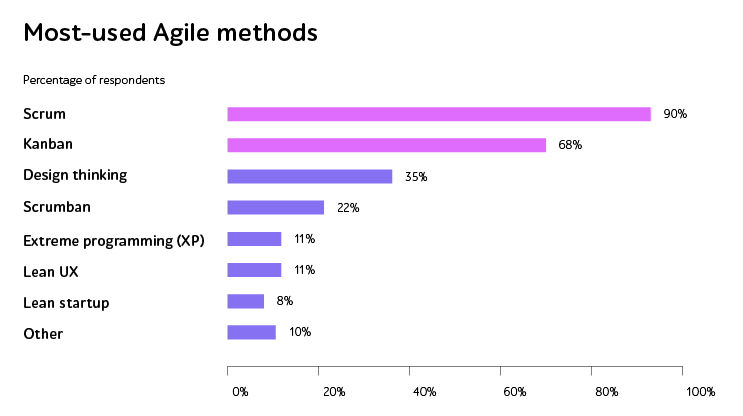
Winning the competition: how to accelerate time to market
Are there any companies that haven’t met even the slightest challenges within the crisis? Timelines. Customer needs. End-users’ behavior. Yes, we all continue adapting to multiple transformations and solving issues we have never faced before.
Let’s turn to some unbiased researches. Forrester says, we have three scenarios of further events from the best-case to the worst ones. The negative playbook highlights that economic declines can continue until 2022.
Alternatively, unstable conditions provide the ground for time for speed, as the crisis has accelerated the transition to a new digital future.
There is no surprise that organizations strive to get the first place in the market, even with more force. In this article, we will discuss how to deliver top-notch IT solutions at tight deadlines, helping compete to win.
It all starts with the team…
Well-defined workflow is a key element in building effective processes, encouraging meeting the timelines and decreasing downtime. Hence, setting up clear and transparent operations seems to be important at all project stages, including software testing.
A team with the necessary skillset is a force for progress. Have neither resources nor wish to onboard and train new QA specialists? A dedicated team model (DTM) might become a way out helping get a needed number of tech and industry-oriented engineers, motivated and committed to the business needs.
Having long-term experience in managing Agile teams, here, a1qa Head of testing department sheds light on a1qa approach to the DTM and its benefits.
Increasing time to market: best practices
The demand for top-level products is soaring, so this is the high time for companies to focus on optimizing the software development process. There are some extra tips on how to improve it and stay confident in the products’ quality.
Get it done through Agile
The 14th annual state of Agile report indicates that accelerating software delivery and enhancing the ability to manage changing priorities remain the top reasons stated for adopting Agile. Moreover, companies get other values through applying the methodology, for instance, increased team productivity and software quality elevation.
Organizations implement various approaches according to their business needs. The most widespread and effective ones are Scrum and Kanban, according to Gartner.

These practices are leveraged in line with a team. However, it is not enough. To have a competitive advantage on the market, one should adapt within the entire organization.
But without a clear strategy, it becomes more difficult for businesses that aim at scaling Agile to forecast results, build trusting relationships between teams, and focus on core activities.
Let’s take SAFe, an agile adaptation that is used for large transformation programs. In the heart of it, one can see the equality of ALL team members, so that each participant promptly realizes the business goals and knows, which actions to make to reach them.
With SAFe, you can release high-quality software faster, but it’s not only about cost-effective development. It helps the company to expand its forces due to a prudential and flexible approach to re-imagining the mindset. SAFe engages all employees, along with the top management and C-level reps.
This is how it becomes easier to increase team motivation to care jointly about the main project goal and raise responsibility for the overall result. On the other side, it helps adapt products to rapidly changing market requirements.
Speed up with continuous testing
Those standing on the DevOps side of things get not only flawlessly working apps, but also a strong increase in teams’ performance and the release cycles reduction. Why so? Because of DevOps core principles of decreasing costs, expanding automated operations, and improving configuration management.
Continuous testing (CT) is that one part helping test early, often, and faster, consisting of three essential parts:
- Continuous integration allows providing regular code updates (up to several times per day). At this stage, QA specialists perform code-level tests (unit and integration checks).
- Continuous deployment ensures code roll-out after adding amendments and can be automated, followed by end-to-end tests to check each new functionality.
- Test automation speeds up the processes and helps find bugs early in contrast with manual testing, which can be pretty much time-consuming and hard-to-perform.
Moreover, running autotests in parallel reduces the testing cycle time and allows getting quality reports in a matter of seconds.
While testing IT solutions, an engineer can design an autotest for the needed functionality, and it can be carried out on different platforms, browsers, devices, OSs, and more simultaneously.
Throughout upcoming releases, specialists save precious time for more creative tasks (ad-hoc, exploratory testing), as they do not have to write new scripts. The value is clear: development cycles decrease.
It should be noted that automation brings a high ROI when the project is long-term (6+ months), and software business logic is occasionally modifying while functionalities are constantly tested. However, automation isn’t a silver bullet. Imagine you have a feature that is to be checked frequently and isn’t likely to change in several weeks. This test case is worth automating.
So, what can you get by adopting continuous testing?
- Enhanced software quality
- Sped up time to market
- Minimized number of defects
- Accelerated work operations
- Increased team motivation
- Early feedback from end users at the earliest SDLC stages.
We still hear a misconception that there is no place for QA if the code is not written. “Shift-left” strategy is just about onboarding QA specialists at the initial SDLC stages. This is where they start studying the requirements, app’s architecture, and writing test documentation that provides fixing possible inaccuracies even before the code is prepared. It goes without saying that the developers’ time is wisely saved. There, the requirements are tested to make sure there are no ambiguities and discrepancies, helping create a useful guide for the code design.
Moreover, CT and “shift-left” testing are not the same things, when the first can be performed at any stage, and the second is focused on the first steps of the software development life cycle, such as requirement collection and analysis.
Summing up
To drive rapid, tangible results and get substantial value even under unstable conditions, we advise concentrating on shortening product delivery time. By implementing Agile and DevOps practices and setting a well-tuned workflow process, one can enhance the software lifecycle and save the development time sustaining top-line growth.
Would you like to speed up the delivery process without compromising the software quality but now sure where to start? Get help from our QA experts.








